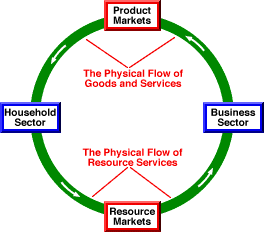
|
|
PERFECT COMPETITION: An ideal market structure characterized by a large number of small firms, identical products sold by all firms, freedom of entry into and exit out of the industry, and perfect knowledge of prices and technology. This is one of four basic market structures. The other three are monopoly, oligopoly, and monopolistic competition. Perfect competition is an idealized market structure that's not observed in the real world. While unrealistic, it does provide an excellent benchmark that can be used to analyze real world market structures. In particular, perfect competition efficiently allocates resources.
Visit the GLOSS*arama
|
|


|

|
                           PHYSICAL FLOW: In the circular flow model, the transfer of goods and services from the business sector to the household sector and the transfer of resource services from the household sector to the business sector. The physical flow is usually illustrated as a counter-clockwise flow for a model with the product markets at the top, resource markets at the bottom, household sector at the left, and business sector at the left. The payment flow moves in the opposite direction. The physical flow, the physical movement of goods and services, is the foundation of the circular flow model. The fundamental problem of scarcity is addressed by physically transforming scarce resources into goods and services that are then used to satisfy wants and needs. This requires the physical exchange of commodities between the household sector, which has the resources, and the business sector, which produces the goods.A Simple ExampleFor example, when Alicia Hyfield buys a Waldo's Super Deluxe TexMex Gargantuan Taco this taco "flows" from the Waldo's TexMex Taco World in the business sector through the product markets and ends up in the possession of Alicia, a member of the household sector.In addition, the labor services of Edgar Millbottom, an employee of Waldo's TexMex Taco World, "flows" from the household sector through the resource markets and ends up with Waldo's TexMex Taco World in the business sector, where it is used in the production of an Waldo's Super Deluxe TexMex Gargantuan Taco. A Simple Model| The Physical Flow |  |
This diagram illustrates the physical flow aspect of the circular flow. This is, by the way, the simplest version of the circular flow model. This model contains two sectors. At the far left is the household sector, containing people seeking consumption. At the far right is the business sector doing the production. Two sets of markets are also included. At the top are the product markets that exchange final goods and services, or gross domestic product. At the bottom are the resource markets that exchange the services of the scarce resources.A reasonable starting point for tracing the payment flow is the household sector. Because it owns all resources, it supplies the services of these resources to the business sector through the resource markets. The business sector then uses the resources to produce the goods and services that are then supplied to the household sector through the product markets. This flow of resources from the household to the business sector and production from the business to the household sector is the physical flow. Running Through the Physical FlowHow about a few notable points on this physical flow?- First, focusing on product markets, the household sector is the demand-side and the business sector is the supply-side. Production flows from the business sector to the household sector through the product markets.
- Second, looking at resource markets, the household sector is the supply-side and the business sector is the demand-side. Resource services flow from the household sector to the business sector through the resource markets.
- Third, the household sector sells the resources through the resource markets and buys goods through the product markets. The household sector does the consumption. It supplies the resources that are used to produce the consumption goods that satisfy wants and needs.
- Fourth, the business sector buys resources through the resource markets and sells goods through the product markets. The business sector does the production. It buys the resources that it transforms into wants-and-needs-satisfying goods.
A Word About the Payment FlowThe physical flow of goods, services, and resources is countered by the payment flow that moves in the opposite direction. The payment flow is the movement of money payments from the household to the business sector in exchange for final goods and services and from the business to the household sector in exchange for the services of resources. The payment flow is usually represented as a clockwise movement.

Recommended Citation:PHYSICAL FLOW, AmosWEB Encyclonomic WEB*pedia, http://www.AmosWEB.com, AmosWEB LLC, 2000-2025. [Accessed: July 18, 2025].
Check Out These Related Terms... | | | | | | |
Or For A Little Background... | | | | | | | | | | | | |
And For Further Study... | | | | | | | | |
Search Again?
Back to the WEB*pedia
|



|

|
RED AGGRESSERINE
[What's This?]
Today, you are likely to spend a great deal of time at a flea market wanting to buy either a weathervane with a cow on top or a box of multi-colored, plastic paper clips. Be on the lookout for telephone calls from long-lost relatives.
Your Complete Scope
This isn't me! What am I?
|

|
|
Paper money used by the Commonwealth of Massachusetts prior to the U.S. Revolutionary War, which was issued against the dictates of Britain, was designed by patriot and silversmith, Paul Revere.
|

|
|
"A winner is someone who recognizes his God-given talents, works his tail off to develop them into skills, and uses those skills to accomplish his goals. " -- Larry Bird, basketball player
|

|
BCUA
Business Computers Users Association
|

|
|
Tell us what you think about AmosWEB. Like what you see? Have suggestions for improvements? Let us know. Click the User Feedback link.
User Feedback
|


|


